The mode of arrangement of petals or sepals in a flower bud with respect to the members of the same whorl or with each other is known as aestivation. It is of following types Valvate Margin of adjacent petals or sepals touch each other, but do not overlap, e.g., mustard (Brassica).
Twisted Regular overlapping of petals or sepals occurs in which margin of one petal overlap with the adjacent next one petal, e.g., China rose (Hibiscus rosa sinensis).
Imbricate There are five petals arranged in such a way that one petal is completely external and one petal is completely internal, three petals are partially external and partially internal, e.g., Cassia, Callistemon, Caesalpinia.
Quincuncial There are five sepals or petals of which two are completely out and two are completely inside, while one is partially out and partially in e.g., Cucurbita (Cucurbitaceae). Vexillary It is the characteristic aestivation of corolla of family - Papilionaceae, in which corolla (petals) are papilionaceous.
The largest petal overlap the two lateral petals (wings), which in turn overlap the two smallest anterior petals (keel) e.g., Artobotrys, Polyalthea, Pisum.
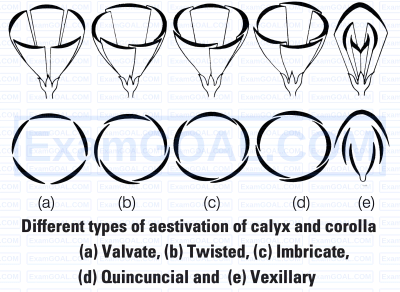
Placenta is a flattened, cushion like tissue on which one or more ovules are attached. The various types of placentation seen in the flowers are described in the following table
| Type of Placentation | Description with example | Diagram |
|---|---|---|
| Marginal | There is a single placenta which develop along the junction of two fused margins, e.g., pea. | 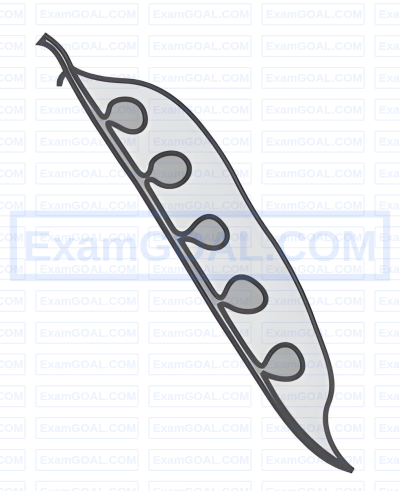 |
| Axile | Mutlicarpellary, syncarpous gynoecium inward growth of carpel's margin forms a multicarpellary condition that contains an axis in the centre. Placenta arises from central axis bearing ovules. e.g., Solanum, China rose. | 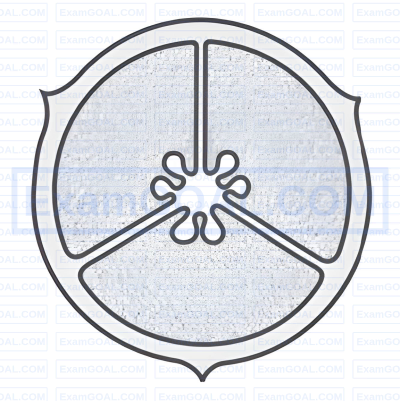 |
| Parietal | The number of placenta corresponds to number of fusing carpels. Sometimes the ovules bearing placenta grow inward to form false septa and thus ovary becomes bilocular (e.g., mustard) and trilocular e.g., Curcurbita | 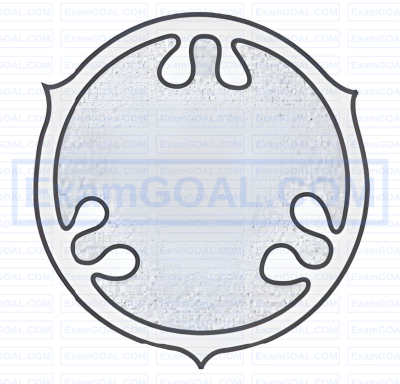 |
| Free central | The ovary is unilocular and ovules are borne on the central-axis and not connected to the ovary wall by septum. e.g., Dianthus, Silensa. | 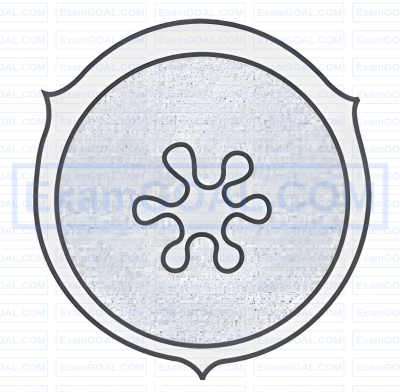 |
| Basal | The ovary is unilocular and the single ovule is borne at the base of the ovary attached by a single placenta, e.g., sunflower, wheat. | 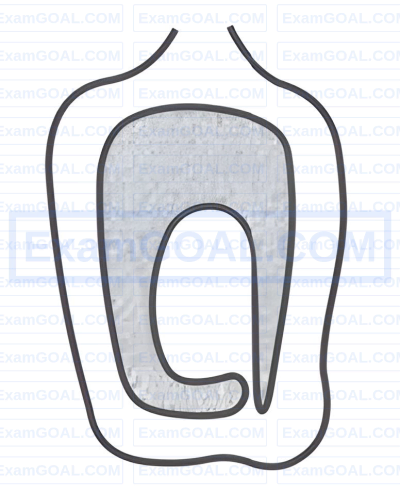 |
Sunflower is not a flower, but it is a kind of inflorescence called capitulum in which the receptacle is flattened. It bears numerous sessile and small florets. The youngest floret is in the center and oldest lies at the periphery. Whole cluster of florets gets surrounded by bracts, known as involucre.
Two kinds of florets are recognised in sunflower
(i) Ray Florets Arranged on the rim of receptacle having distinct yellow and strap shaped petals. These florets are female, sterile and are always zygomorphic and may be arranged in one or more whorls.
(ii) Disc florets Grouped in the center, bisexual and actinomorphic.
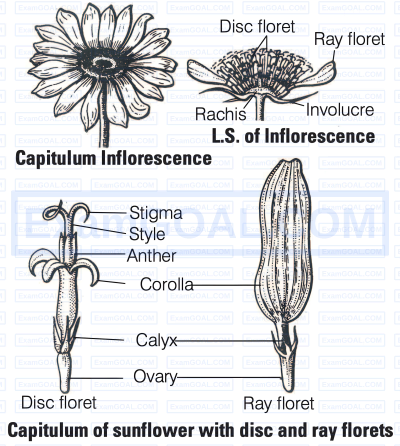
Difference between hypogeal germination and epigeal seed sermination are as
| Hypogeal Seed Germination | Epigeal Seed Germination |
|---|---|
| Rapid growth and elongation of epicotyl. Cotyledons remain inside the soil. Cotyledons remain non-green, non photosynthetic e.g., castor, beans. 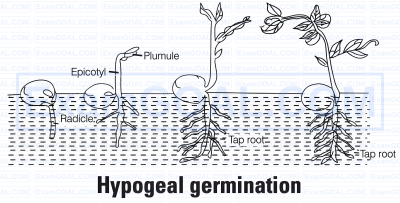 |
Rapid growth and elongation of hypocotyl. Seed cotyledons emerge above the soil level/ Cotyledons become green and photosynthetic e.g., maize, rice. 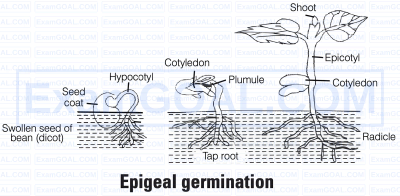 |
Role of Cotyledons and Endosperm Cotyledons and endosperm contain reserved food materials. When seed imbibes water, enzymes get activated, hydrolyse reserve food material and makes it available for the germinating seed.
Dormant seeds remain under non-germination conditions only for a specific period of time that may vary from days to years. This specific period is called dormancy period.
Causes of Seed Dormancy
(a) In many plants the cause of dormancy is due to the impermeability of seed coat to water, (e.g., Chenopodium, Trigonella, Meliotus) or oxygen (e.g., Brassica alba, Pyrus malus-Apple, Sinapis arvensis) or chemicals, (e.g., Xanthium)
(b) In many plants, tough (hard) seed coats are the cause of dormancy as they provide mechanical resistance to embryo growth, e.g., Capsella, Lepidium.
(c) Some seeds produce certain chemical substances, such as abscisic acid (ABA,most common), phenolic acids, coumarin, short chain fatty acid, etc. which inhibit the seed germination. These inhibitors may be present inside the fruit, (e.g., the fruit juice of tomato contains ferulic acid), in the embryo (e.g., Xanthium), endosperm, (e.g., Iris) or seed-coat, (e.g., Cucurbita)
(d) Shedded seeds like those of wheat, barley, oat etc., need an interval for ripening and gaining the ability to germinate. During the interval, the seeds produce necessary growth hormones.
Methods of breaking dormancy are as follows
(i) Inactivation of growth inhibitors by heat or cold treatment.
(ii) Mechanical abrasions weaken the tough and impermeable seed coat.
(iii) Microorganisms present in the soil weaken and decompose hard seed coat.
(iv) Washing away of inhibitors by rain or irrigation water.
(v) Maturation of embryo.